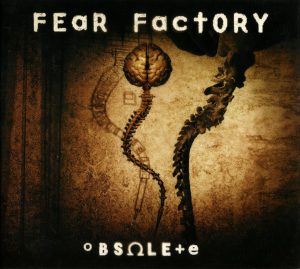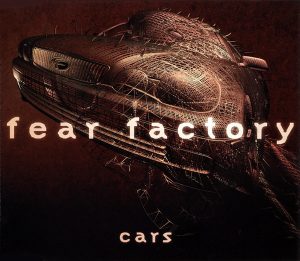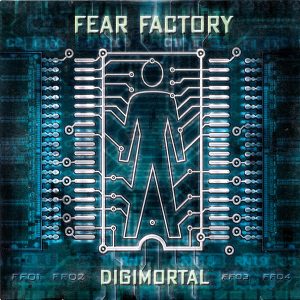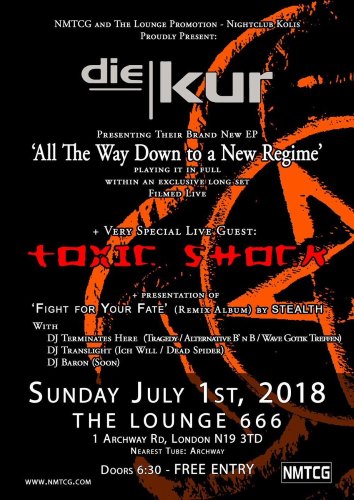Obsolescence
The term ‘concept album’ tends towards overuse – both of the albums covered so far have been assigned the term at some point. However, their third studio effort – 1998’s Obsolete – is more deserving of the term than any of their other releases. Not only because it sees further experimentation in terms of their overall sound, but because it forms the basis for an underlying story. The CD inlay, adorned with Dave McKean’s artwork, provides a narrative that joins the songs together. And unlike many concepts, the individual songs stand up individually as well as part of the whole.
Shock is classic Fear Factory, Dino’s guitars and Burt’s vocal blasts firing off one another, with the electrical metaphor stating a desire to be a ‘shock’ to the corrupt system very much in tune with the bands stance. But the first curveball is up next, a song about the central character of the Obsolete story – the Edgecrusher. The use of an upright bass and a rap-metal vocal gives the song a rhythmic groove quite unlike anything they’ve put out before, the use of a DJ scratcher adds a further hip-hop influence, but when the riff kicks in for the chorus, you’re still more likely to see a mosh pit break out that a breakdance. Whether the ‘Factory were consciously cutting themselves a slice of the nu-metal action or just picking up some LA street vibes, this song stands out as their lasting crossover anthem.
Smasher-Devourer takes us back to the safer territory of the machine metal grind as an analogy for law enforcement, very much in the ‘Demanufacture’ spirit musically and thematically. The middle part of the album delivers the most variety in terms of both variety and quality, with the rich guitars and reflective tone of Descent borrowing heavily from early 80s-Killing Joke without losing any of their usual impact. Gary Numan gets a spoken-word intro to Obsolete, but the song it prefaces is an unmemorable standard-issue, whilst some of the other songs get caught up in structural complexity swamping what should have been the hooks.
But then we get Resurrection, which brings a string section into the mix. Symphonic parts of metal songs may not seem unusual today, especially to us Europeans, but this is from the late 90s USA – unless you count Metallica’s S&M, classical influence simply did not feature. The result is the most emotive, uplifting song Fear Factory have produced, the one beacon of hope on an album that otherwise unremittingly bleak in concept. The strings stay for the concluding Timelessness, the guitars and drums disappearing along with Edgecrusher’s hope, much to the chagrin of your average metalhead, though it serves as a fitting coda to the story and a final demonstration of Burton’s vocal talents.
Singles and Versions: ‘Resurrection’ became a single, with the song cut down to fit. B-side to this include an workmanlike Wiseblood cover “0-0 (Where Evil Dwells)” plus “Soulwound”, a remake of one of their early demo tracks. Later versions of this album usually include these B-sides, plus a few additional offcuts that also seem to have been pulled out of their early works archive. Thankfully, they also include their cover of “Cars” – speaking of which….
Cars was released as a standalone single in 1999 – a Numan cover with Gary himself providing some of the vocals. Fear Factory’s brutally precise guitar rhythms turn out to adapt perfectly to the hard edges of the original synthpop chart-topper, and it remains one of the best remembered of the many ‘90s metal band covers 80s new wave’ recordings of the era. This single also offers a couple of breakbeat mixes of “Edgecrusher” (by rap artist Mad Child) and “Descent” (Junkie XL once again), the spirit of Remanufacturing Factory songs to dancefloor specification still very much alive.
Little did we know it at the time, but the final album by the ‘classic’ line-up would be 2001’s Digimortal. Musically, it’s not significantly different from the two albums that came before it, with the only real changes being a shift to shorter, more accessible song structures, more prominence of the electronics in the mix, and the lack of any real story arc, with the rather vague ‘man and machine in co-existence’ theme the official concept. And where the guitar salvos and high-frequency squealing synths of opener What Will Become burst through the speakers, anyone who has any appreciation of this brand of technologically enhanced metal will be right at home.
The first half of this album rarely stays from this path, Damaged, Digimortal and No One firing off in quick succession, only occasionally pausing for breath, before culminating with Linchpin. It’s the obvious hit, the mid-tempo metal groove providing a bridge to the Panteras and Machine Heads of the world, though the technological enhancements and dual vocal styles that typify this bands finest tracks set this one apart in what was in the early 00s an increasingly crowded genre.
Invisible Wounds (Dark Bodies) is the real stand-out – more ‘mortal’ than ‘digi’, the melancholy guitar twang, the reflective nature of the lyrical content and some of Burton’s strongest vocal harmonies stand out on an album which has so far done much to impress, but little to surprise. The big riffs are still here, but on this occasion, Dino uses them to build the song to it’s climax, as opposed to serving its fundamental purpose.
The latter stages of the album never really match this two-song central peak. Acres of Skin is marginally closer to the death/grind of their earlier work, Back The Fuck Up is a forced and misguided attempt to one-up the nu-metal salute of “Edgecrusher” via use of guest rapper B-Real, and Byte Block and (Memory Imprints) Never End respectively go for ‘structurally complex technical workout’ and ‘drawn out album closer’ but falling slightly short equalling the glories of past compositions along the same lines. None of these track ‘spoil’ the album as such. It’s just that there’s a distinct impression that this particular avenue of Fear Factory creativity has reached its limit. The events of the next couple of years would serve as proof.
Singles and Versions: There’s a digipak version of the album with four bonus songs, though as usual with these tacked-on extras, they pale in comparison with the album’s better moments. ‘Linchpin’ unsurprisingly became the lead single, with versions offering either a couple of equally unexceptional bonus tracks or some low-definition video clips (remember – this is CD-video era – DVDs were the new big thing at the time!).







